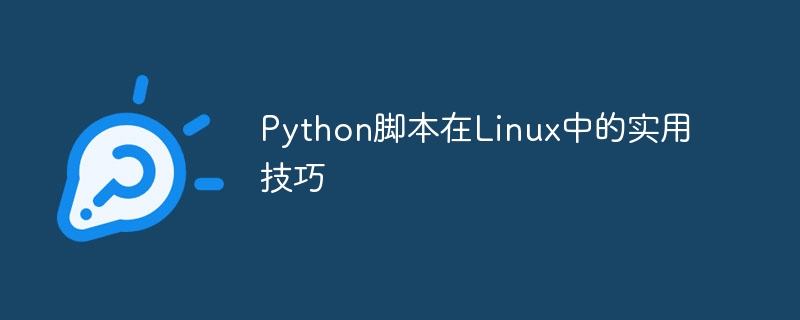
Python腳本在Linux中的實用技巧,需要具體程式碼範例
引言:
Python是一種可廣泛應用於各種領域的程式語言,而Linux作為一個免費且開放原始碼的作業系統,被廣泛應用於伺服器、嵌入式設備等領域。在Linux環境下,Python腳本可以發揮強大的威力,幫助我們完成各種任務。本文將介紹一些在Linux中使用Python腳本的實用技巧,並提供具體的程式碼範例。
一、Shell指令與Python結合
在Linux中,我們常常需要使用Shell指令來執行一些系統級的操作。 Python提供了os模組和subprocess模組,可以方便地呼叫Shell指令。以下是一些常見的範例:
1.執行Shell指令並取得輸出:
import subprocess
result = subprocess.check_output("ls -l", shell=True)
print(result.decode())2.執行多個Shell指令:
import subprocess
commands = [
"sudo apt update",
"sudo apt upgrade -y",
"sudo apt install python3-pip -y",
]
for cmd in commands:
subprocess.call(cmd, shell=True)3.透過Shell指令重定向輸出:
import subprocess
with open("output.txt", "w") as f:
subprocess.call("ls -l", shell=True, stdout=f)二、檔案與目錄操作
Linux系統中的檔案和目錄操作是經常遇到的任務,Python提供了os.path模組和shutil模組用於處理檔案和目錄。
1.建立目錄:
import os
os.makedirs("my_directory")2.刪除目錄及其內容:
import shutil
shutil.rmtree("my_directory")3.遍歷目錄中的檔案:
import os
for root, dirs, files in os.walk("my_directory"):
for file in files:
print(os.path.join(root, file))三、網路操作
Linux環境下的網路操作是非常常見的,Python提供了socket模組和requests模組來處理網路請求。
1.發起HTTP請求:
import requests
response = requests.get("https://www.example.com")
print(response.text)2.建立簡單的Web伺服器:
import http.server
handler = http.server.SimpleHTTPRequestHandler
httpd = http.server.HTTPServer(("", 8000), handler)
httpd.serve_forever()3.建立簡單的SMTP客戶端:
import smtplib
from email.message import EmailMessage
msg = EmailMessage()
msg.set_content("Hello, World!")
msg["Subject"] = "This is a test email"
msg["From"] = "sender@example.com"
msg["To"] = "recipient@example.com"
with smtplib.SMTP("smtp.example.com") as server:
server.send_message(msg)結論:
本文介紹了一些在Linux中使用Python腳本的實用技巧,包括與Shell命令的結合、檔案與目錄操作以及網路操作。透過這些技巧,我們可以更好地利用Python的強大功能來完成各種任務。以上範例程式碼僅為示範,讀者可以根據自己的實際需求進行修改和擴展。
(字數:371)
以上是Python腳本在Linux中的實用技巧的詳細內容。更多資訊請關注PHP中文網其他相關文章!




